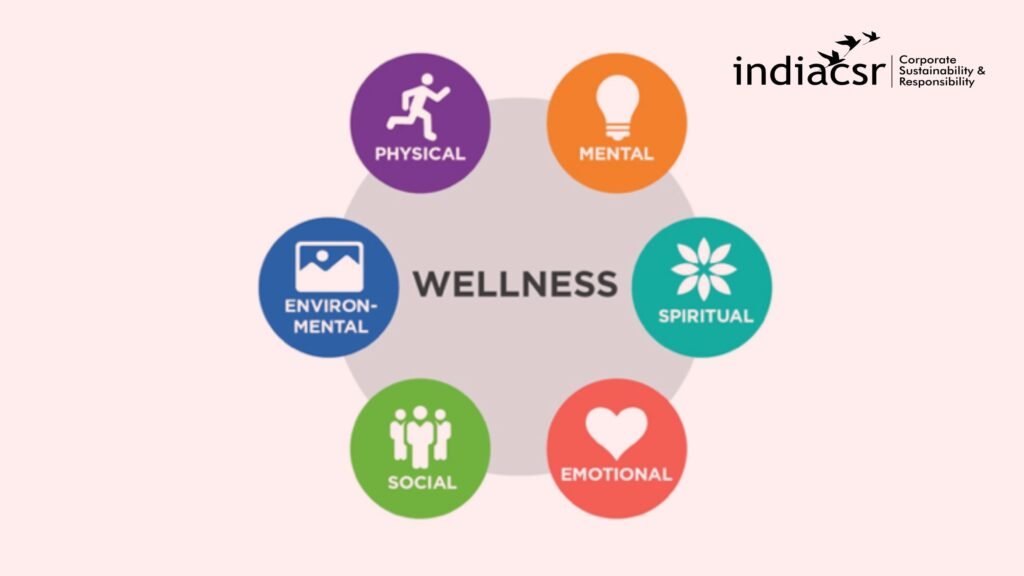Fitness pertains to physical health and wellness is a holistic approach to overall well-being. Maintaining both is important for living a healthy, balanced life.
Welcome readers! Are you looking to improve your physical fitness and overall well-being? In this article, we will be discussing the difference between fitness and wellness, and providing an overview of common practices for maintaining both. The article will also be providing a comparison table to help you understand the distinct meanings of these terms.
Fitness and wellness are often used interchangeably, but they have distinct meanings. Fitness refers to the ability to perform physical activity and is often associated with exercise and sports. It involves the improvement of cardiovascular health, muscle strength, and flexibility. Regular exercise can lead to increased energy levels, weight loss, and a reduced risk of chronic diseases.
Also Read: Six Dimensions of Total Wellness I India CSR
What is Wellness?

Wellness, on the other hand, is a holistic approach to health and well-being. It encompasses not only physical fitness but also mental and emotional well-being. Wellness involves taking care of the whole person, including their physical, mental, and emotional health, as well as their social and spiritual well-being.
Wellness, on the other hand, is a holistic approach to health and well-being. It encompasses not only physical fitness but also mental and emotional well-being. Wellness involves taking care of the whole person, including their physical, mental, and emotional health, as well as their social and spiritual well-being.
What is Fitness?

Fitness refers to the ability to perform physical activity and is often associated with exercise and sports. It involves the improvement of cardiovascular health, muscle strength, and flexibility. Regular exercise can lead to increased energy levels, weight loss, and a reduced risk of chronic diseases.
In short, fitness is a component of wellness. While regular exercise is an important part of achieving wellness, it is not the only factor. To truly be well, one must also focus on their mental and emotional health, their relationships, and their overall sense of purpose and fulfillment.
Common practices for maintaining wellness

Some common practices for maintaining wellness” refers to different activities or habits that can help an individual achieve a state of overall well-being. Here is a brief explanation of each practice:
Eating a balanced and healthy diet
This means consuming a variety of nutrient-dense foods that provide the body with the essential vitamins, minerals, and nutrients it needs to function properly. Eating a balanced diet can help prevent chronic diseases, maintain a healthy weight, and improve overall energy levels.
Getting enough sleep
Sleep plays a vital role in overall health and wellness. It allows the body to repair and rejuvenate itself, and can improve mood, memory, and cognitive function. It’s recommended to get 7-9 hours of sleep per night for adults.
Managing stress through mindfulness, yoga, and meditation
Stress can have a negative impact on physical and mental health. Mindfulness, yoga, and meditation are practices that can help reduce stress and improve overall well-being.
Building and maintaining strong relationships
Strong relationships with friends and family can provide emotional support, a sense of belonging, and improve overall happiness.
Pursuing hobbies and interests
Having hobbies and interests can provide a sense of purpose and fulfillment, and can also be a great way to relax and unwind after a long day.
Setting and working towards personal and professional goals: Having goals to work towards can provide a sense of purpose and direction, and can also improve motivation and self-esteem.
Common practices for maintaining wellness

Are you looking to improve your physical health and fitness? Here are some common practices that can help you achieve your fitness goals and maintain a healthy and active lifestyle.
Cardiovascular exercise
These are activities that increase the heart rate and breathing, such as running, cycling, swimming, or brisk walking. They help improve cardiovascular health, increase endurance and can aid in weight management.
Strength training
These exercises focus on building muscle mass and strength, such as weightlifting or bodyweight exercises like push-ups, squats, and pull-ups. Strength training can improve muscle and bone health, increase metabolism, and reduce the risk of injury.
Flexibility and stretching exercises
These activities, such as yoga or Pilates, are designed to improve flexibility, range of motion and balance. They can prevent muscle soreness, reduce the risk of injury, and promote overall relaxation.
High-intensity interval training (HIIT)
This is a type of workout that alternates short bursts of intense activity with periods of rest. HIIT can be an efficient and effective way to improve fitness, burn calories and boost metabolism.
Consistently tracking progress
Keeping a fitness journal or using an app to track progress can help you stay motivated and see progress over time. It can also help you identify areas that need improvement.
Incorporating variety in workout routines
Doing the same workout routine can lead to boredom and plateaus. Incorporating variety in your workout routine can help to challenge your body and prevent these issues.
Getting enough rest and recovery time
It’s essential to give your body adequate time to recover between workouts. Rest days allow your muscles to repair and rebuild, preventing injury, and helping to improve overall fitness.
Setting and working towards specific fitness goals
Setting specific, measurable, achievable, realistic and time-bound (SMART) fitness goals can help you stay motivated and on track. It can also help you to stay focused and to monitor progress.
It’s important to note that these practices are not mutually exclusive, and not all will be applicable or suitable for everyone, but incorporating them in your life can bring a great improvement to your overall well-being.
It is important to note that wellness is not a destination, but a journey. Everyone’s needs and priorities will be different, and what works for one person may not work for another. The key is to find what works for you and make it a regular part of your life.

Comparison of Fitness and Wellness
| Fitness | Wellness |
| Refers to the ability to perform physical activity | A holistic approach to health and well-being |
| Improves cardiovascular health, muscle strength, and flexibility | Encompasses physical, mental, and emotional well-being, as well as social and spiritual well-being |
| Associated with exercise and sports | Involves taking care of the whole person |
| Leads to increased energy levels, weight loss, and reduced risk of chronic diseases | Focuses on overall sense of purpose and fulfillment |
| A component of wellness | More than just fitness |
Final words, fitness and wellness are related but distinct concepts. Fitness pertains to physical health and wellness is a holistic approach to overall well-being. Maintaining both is important for living a healthy, balanced life.

Disclaimer:
The information provided in this article is intended for general informational purposes only and is not intended as a substitute for professional medical advice, diagnosis, or treatment. It is important to consult with a qualified healthcare professional before making any changes to your exercise or diet regimen. Any exercise program may result in injury, and it is the responsibility of the reader to ensure proper form and technique, and to seek medical advice and attention in the case of injury. The author and publisher of this article assume no liability for any injury or damage sustained as a result of the information provided.







